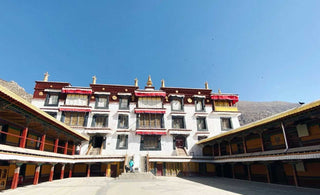
Exploring the Cultural Tapestry of Tibetan Murals
The allure of Tibetan murals lies not only in their vibrant colors and intricate designs but also in the captivating stories and legends they portray. These breathtaking artworks, adorning the walls of monasteries and palaces, are more than mere paintings; they are visual narratives that encapsulate the rich heritage, spiritual beliefs, and historical tales of Tibet.
Unveiling the Rich History of Tibetan murals
Tibetan murals, often found within the sacred walls of monasteries like the famed Potala Palace, carry a profound historical significance. Each stroke of the brush on these ancient walls tells a story, offering glimpses into the cultural, religious, and political landscape of Tibet throughout the ages. Nestled within the walls of monasteries and sacred spaces like the revered Potala Palace, these magnificent artworks serve as living testaments to a bygone era, offering profound insights into the historical narrative of Tibet.
These murals serve as windows into the past, narrating tales of Tibetan emperors, religious figures, and mythical legends. These murals, often centuries old, are exquisite renderings that chronicle the diverse facets of Tibetan history, capturing the essence of dynasties, spiritual evolution, and the societal landscape. Their strokes echo tales of conquests, reigns of kings, and the propagation of Buddhism across the Tibetan plateau.
The murals within the Potala Palace, once the residence of successive Dalai Lamas and a center of Tibetan governance, depict not just the eminence of Tibetan rulers but also reflect the intricate interplay between religion and politics. They narrate the intricate dance between the spiritual authority of the Dalai Lamas and the worldly affairs that shaped Tibet's destiny.
From the Potala Palace's earliest murals portraying the historic journey of Buddhism's arrival in Tibet to the subsequent depictions of the empire's expansion and the lives of the revered spiritual leaders, each stroke on these walls symbolizes an epoch, painting a vivid picture of Tibet's storied past. These visual narratives transcend the boundaries of time, providing a compelling glimpse into the vibrant history of Tibet. They resonate with tales of valor, wisdom, and devotion, immortalizing the tales of visionary leaders, spiritual masters, and cultural milestones that have sculpted the very essence of Tibetan identity.
The artistic brilliance on these walls isn't merely a reflection of creativity; it's a window into the soul of Tibetan civilization. Layer by layer, these murals peel back the veils of time, offering enthusiasts and scholars a unique opportunity to connect with an illustrious past that continues to reverberate through the ages.
Decoding Symbolism and Legends
Beyond their historical significance, Tibetan murals are repositories of symbolism. Intricate symbols, vibrant motifs, and celestial depictions imbue these artworks with layers of meaning, often conveying spiritual teachings and profound philosophies rooted in Tibetan Buddhism.
The colorful compositions within these murals unfold tales of deities, bodhisattvas, and mythical creatures. Take, for instance, the portrayal of Bodhisattvas—enlightened beings who embody compassion and wisdom. These divine figures, depicted in radiant hues and adorned with symbolic accessories, represent the compassionate ideals embraced within Tibetan Buddhism. Every attribute, from the hand gestures (mudras) to the intricate garments, carries profound meaning, inviting the viewer into the realm of spiritual contemplation.
Moreover, the Wheel of Life, a recurrent motif in these murals, illustrates the cyclical nature of existence—a visual representation of birth, death, and rebirth. Its intricate design, divided into segments depicting various realms and states of being, serves as a reminder of the impermanence of life and the pursuit of enlightenment to transcend this cycle.
Embedded within the strokes of the brush lie tales of legendary figures and mythical creatures. The epic stories of Guru Rinpoche, the legendary Padmasambhava, revered as the "Second Buddha," are vividly depicted in these murals. His miraculous deeds and teachings echo through the vibrant colors, narrating the triumph of spirituality over adversity.
Furthermore, Tibetan murals often portray celestial realms inhabited by mystical beings like the Dharmapalas, protective deities entrusted with safeguarding the Buddhist teachings. Their fierce yet benevolent depictions symbolize the perpetual battle against ignorance and the protection of spiritual truths.
These murals serve as more than artistic masterpieces; they are visual scriptures, guiding devotees on their spiritual journey. Monks and practitioners seek enlightenment through meditative contemplation on these paintings, using them as aids for visualization and spiritual introspection.
For enthusiasts and scholars, these artworks provide a fascinating avenue for scholarly pursuits, inviting deeper research into the historical, cultural, and philosophical aspects of Tibetan Buddhism. Deciphering the symbolism and unraveling the stories depicted in these murals becomes a quest for understanding the profound teachings embedded within.
Connecting with Oriental Aesthetics
At Oriental Aesthetics, we foster a deep appreciation for the classical art forms of the Orient. Our dedication to preserving and promoting Oriental art extends to the meticulous curation of Tibetan murals, offering a platform for artists, collectors, and enthusiasts to explore and acquire these invaluable treasures.
Oriental Aesthetics stands as a premier institution, providing systematic, high-quality professional services catering to Oriental artists, collectors, and enthusiasts. Our services are not limited to business operation with 150 channel groups, we also possess an integrated online platform supporting artists with their works exhibited online. With a focus on authenticity and cultural significance, we strive to bridge the gap between artists and connoisseurs, ensuring the legacy of Oriental art thrives for generations to come with various media dedicated to expand the influence of oriental arts.























